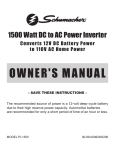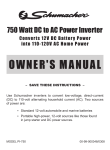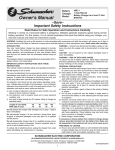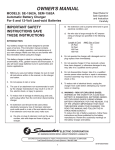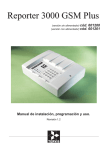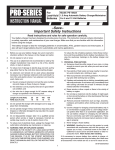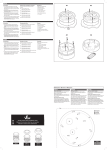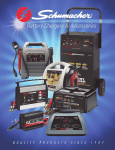Download Schumacher 200A Battery Charger User Manual
Transcript
OWNER’S MANUAL Model 200A For 6 and 12-Volt Lead-Acid Batteries SpeedCharge ™ Fully Automatic 2 Amp, 12 Volt 4 Amp, 6 Volt Battery Charger/ Maintainer with Float-Mode Monitoring CAUTION: Read all Safety Rules and Operating Instructions, and follow them with each use of this product. Schumacher Electric Corporation Mount Prospect, IL 60056 U.S.A. Send Warranty Product Repairs to: Customer Service Returns P.O. Box 280,1025 E. Thompson, Hoopeston, IL 60942-0280 Questions? Call Customer Service: 1-800-621-5485 0099000532/1205 TABLE OF CONTENTS IMPORTANT SAFETY INSTRUCTIONS .................................................................... 3 PERSONAL SAFETY PRECAUTIONS ...................................................................... 4 BEFORE USING YOUR BATTERY CHARGER ......................................................... 5 Plugging It In.......................................................................................................... 5 Using An Extension Cord....................................................................................... 5 Battery Clamps....................................................................................................... 5 12v Accessory Plug................................................................................................ 5 Ring Connectors.................................................................................................... 5 USING YOUR BATTERY CHARGER.......................................................................... 6 PREPARING YOUR BATTERY TO BE CHARGED ................................................... 6 OPERATING INSTRUCTIONS ................................................................................... 7 Charging Battery In The Vehicle............................................................................. 7 Charging Battery Removed From The Vehicle....................................................... 8 MAINTENANCE AND CARE ...................................................................................... 8 BATTERY PERCENT AND CHARGE TIME................................................................ 9 LIMITED WARRANTY .............................................................................................. 10 SAVE THIS OWNER’S MANUAL AND READ BEFORE EACH USE. Model 200A, Fully Automatic Battery Charger offers features to accommodate the needs for home or light commercial use. This manual will explain how to use the charger safely and effectively. Please read and follow these instructions and precautions carefully. NOTE: This equipment has been tested and found to comply with the limits for a Class B digital device, pursuant to Part 15 of the FCC Rules. These limits are designed to provide reasonable protection against harmful interference in a residential installation. This equipment generates, uses and can radiate radio frequency energy and, if not installed and used in accordance with the instructions, may cause harmful interference to radio communications. However, there is no guarantee that interference will not occur in a particular installation. If this equipment does cause harmful interference to radio or television reception, which can be determined by turning the equipment on and off, the user is encouraged to try to correct the interference by one or more of the following measures: • Reorient or relocate the receiving antenna. • Increase the separation between the equipment and receiver. • Connect the equipment into an outlet on a circuit different from that to which the receiver is connected. • Consult the dealer or an experienced radio technician for help. Important Safety Instructions WARNING – RISK OF EXPLOSIVE GASES WORKING IN VICINITY OF A LEAD-ACID BATTERY IS DANGEROUS. BATTERIES GENERATE EXPLOSIVE GASES DURING NORMAL BATTERY OPERATION. FOR THIS REASON, IT IS OF UTMOST IMPORTANCE THAT EACH TIME BEFORE USING YOUR CHARGER, YOU READ THIS MANUAL AND FOLLOW THE INSTRUCTIONS EXACTLY. To reduce risk of battery explosion, follow these instructions and those published by battery manufacturer and manufacturer of any equipment you intend to use in vicinity of battery. Review cautionary markings on these products and on engine. save these Instructions • To reduce risk of electrical shock, unplug the charger from the 120V AC electrical wall outlet before attempting any maintenance or cleaning. This manual contains important safety and operating instructions for battery charger Model 200A. • Always charge battery in a well-ventilated area. • WARNING: Handling the cord on this product or cords associated with accessories sold with this product, will expose you to lead, a chemical known to the State of California to cause cancer and birth defects or other reproductive harm. Wash hands after handling. • WARNING: Battery chargers get hot during operation and must have proper ventilation. Air needs to flow around entire charger. Do not set charger on flammable materials like carpeting, upholstery, paper, cardboard, etc. Charger may damage leather, plastic and rubber. • Read all instructions and cautions printed on the battery charger, battery, and vehicle or equipment using battery. Help us help you —— Remember: • Use charger only on lead-acid type rechargeable batteries, such as those used in cars, trucks, tractors, airplanes, vans, RVs, trolling motors, etc. This charger is not intended to supply power to a low voltage electrical system other than in a starter-motor application. Place charger as far away from the battery being charged as the charger cables will permit. Do not expose charger to rain or snow. Never charge a frozen battery. If battery fluid (electrolyte) becomes frozen, bring battery into a warm area to allow battery to thaw before you begin charging. • Never use charger for charging dry cell batteries that are commonly used with home appliances like radios, stereos, remote controls, etc. These batteries may burst and cause personal injury. • Do not disassemble charger. Take it to a qualified service professional if service or repair is required. Incorrect assembly may result in fire or electrical shock. Never allow battery acid to drip on charger when reading specific gravity or filling battery. Never set a battery on top of charger. Never place charger directly above battery being charged. The gases from the battery will corrode and damage the charger. Never touch the battery clamps together when the charger is on. You could cause a spark. Never pull out the plug by the cord when unplugging the charger. Pulling on the cord may cause damage to the cord or the plug. Never operate charger if it has received a hard blow, been dropped, or otherwise damaged. Take it to a qualified professional for inspection and repair. Do not operate the charger if it has a damaged power cord or plug. Have the cord replaced. Be sure to position the charger power cord to prevent it from being stepped on, tripped over, or damaged. Connect and disconnect DC clamps only after removing charger AC power cord from the wall outlet. Do not permit clamps to touch each other. Personal Safety Precautions • Wear complete eye and clothing protection when working with leadacid batteries. appliances. These batteries may burst and cause injury to persons or damage to property. • Make sure that someone is within range of your voice to come to your aid if needed while you work with or are near a lead-acid battery. • Remove all personal metal items from your body such as rings, bracelets, necklaces and watches, while working with a lead-acid battery. A battery can produce a short circuit current high enough to weld a ring (or the like) to metal, causing a severe burn. • Have plenty of fresh water and soap nearby for use in case battery acid contacts your eyes, skin, or clothing. If this happens, wash immediately with soap and water. Then get medical attention. • Take care not to drop any metal tool or metal object onto the battery. This may result in a spark or short circuit across the battery or another electrical device that may cause an explosion. • Avoid touching your eyes while working with a battery. Wear safety glasses. Acid particles (corrosion) may get into your eyes. If this occurs, flush eyes immediately with running cold water for at least 15 minutes. Then immediately get medical attention. • Always operate the battery charger in an open, well-ventilated area. • Never smoke or allow a spark or flame in the vicinity of the battery or engine. Batteries generate explosive gases. • Never charge a frozen battery. • Remove personal metal items such as rings, bracelets, necklaces and watches when working near a lead acid battery. • Neutralize any acid spills thoroughly with baking soda before attempting to clean up. • Use the charger for charging a leadacid battery only. It is not intended to supply power to a low-voltage electrical system other than in an automotive application. Do not use battery charger for charging dry cell batteries that are commonly used with home • If necessary to remove battery from vehicle to charge, always remove grounded terminal from the battery first. Make sure all accessories in the vehicle are off, so as not to cause an arc. BEFORE USING YOUR BATTERY CHARGER It is important to understand the charger’s requirements. This section explains the charger’s electrical requirements and how to prepare a battery for charging. PLUGGING IT IN Your charger requires a 120V AC electrical outlet installed according to all local codes and ordinances. Versatile Quick-Disconnect Harness Snap any of the three connectors into place in seconds: Battery Clamps Connect the clamps to the charger. Follow the Operating Instructions to connect the output clamps to the battery. After a solid electrical connection is made to the battery, plug the power cord into a 120V AC electrical wall outlet. 12V Accessory Plug Charge or maintain your battery without lifting the hood. Connect the 12V adapter to the charger and plug into the 12V accessory outlet. Route the power cord from charger through the vehicle’s open window and plug into a 120V AC electrical wall outlet. Make sure to place charger on a dry, non-flammable surface, like metal or concrete. USING AN EXTENSION CORD The use of an extension cord is not recommended. If you must use an extension cord, please make sure that you follow these guidelines: • Make sure that pins on plug of extension cord are the same number, size, and shape as those of plug on charger. • Check that the extension cord is properly wired and in good electrical condition. • Make sure that the wire size is large enough for its length and for the AC ampere rating, as specified in the chart below. Ring Connectors The ring connectors permanently attach to the battery providing easy access to quickly charge your battery. This application is appropriate for motorcycles, lawn tractors, ATVs and snowmobiles. To permanently attach to a battery, loosen and remove each nut from bolts at battery terminal. Connect the red POSITIVE ring connector ring to the POSITIVE battery terminal. Connect the black NEGATIVE connector ring to the NEGATIVE battery terminal. Replace and tighten the nuts to secure. Take care to keep both wires and plug away from metal and the engine hood. Plug the power cord into a 120V AC electrical wall outlet. MINIMUM RECOMMENDED EXTENSION CORD Length of Cord, in Feet 25 50 100 150 AWG* Size of Cord 18 18 16 14 *AWG=American Wire Gauge Using Your Battery Charger The 200A does not have an ON/OFF switch. The On and Off commands are controlled by plugging the 200A into a 120V AC electrical wall outlet only after battery connections have been made. *Indicates an overload condition caused by shorting of the battery clamps, reverse polarity (hookup) connection to a battery, or charging a problem battery. LED Indicators Charging Charged/ Maintain Check Battery* Amber Green Red Preparing your battery to be charged It is important that you read and follow these guidelines while you are preparing to charge the battery. • Make sure that you have a 6 volt or 12 volt lead-acid battery. Determine voltage of battery by referring to vehicle owner’s manual. Charge battery initially at charger’s lowest rate. • Clean the battery terminals. Be careful to keep corrosion from getting in or around your eyes. • Wear safety glasses. See additional “Personal Safety Precautions” on page 4. • For batteries with removable vent caps, if required, add distilled water to each cell until the battery acid reaches the level recommended by the manufacturer. This will help purge excessive gases from the cells. Be careful not to overfill. If you have a sealed battery with non-removable vent caps, no action is necessary. • Take time to read all of the battery manufacturer’s specific precautions, such as removing or not removing vent caps while charging, and recommended rates of charge. • Be sure that the area around the battery is well ventilated while it is being charged. Gases emitted from the battery can be forcefully blown away by using a piece of cardboard or other nonmetallic material as a fan. • If it is necessary to remove the battery from the vehicle to charge it, always remove the grounded terminal from the battery first. Turn off all vehicle accessories to avoid sparks from occurring. DANGER - Never alter the AC plug provided. If it will not fit the outlet, have a proper outlet installed by a qualified electrician. Improper connection can result in the risk of electrical shock. WARNING ‑ Connect and disconnect the battery clamps only when the AC power cord is disconnected or arcing may result. • NOTE: A marine (boat) battery installed in a boat must be removed and charged on shore. operating instructions IMPORTANT: Follow all safety instructions and precautions when charging your battery. Wear complete eye protection and clothing protection. Charge your battery in a well-ventilated area. Charging Battery In The Vehicle: block, away from the battery (see figure left). DO NOT connect clamp to negative battery post, carburetor, and fuel line or sheet metal part. 1. Avoid personal injury by keeping clear of fan blades, belts, pulleys and other engine parts. 2. Avoid damaging the charger by keeping the power cord and output cords away from the hood, door or moving engine parts. 3. Note the polarity of the battery posts by checking the identification marks on the battery: POSITIVE (POS, P or +) and NEGATIVE (NEG, N or -). The positive post is usually larger than the negative post. 4. Identify which battery post is grounded or connected to the chassis. THIS IS NORMALLY THE NEGATIVE POST. Connecting to a positive-grounded system: Connect the black (NEGATIVE) output clamp to the NEGATIVE post of the battery. Rock and twist the clamp back and forth to be sure a solid electrical connection is made. Then connect the red (POSITIVE) output clamp to a heavy, unpainted metal part of the chassis or engine block, away from the battery. DO NOT connect clamp to positive battery post, carburetor, and fuel line or sheet metal part. 6. Plug power cord into an 120V AC electrical wall outlet. 7. The CHARGING (yellow) LED should light and the charging process should start. If the CHECK (red) LED is on, check for correct cable connections. 8. The charger stops charging automatically after the battery is fully charged. Charge completion is indicated by CHARGED (green) LED and the charger has stopped charging and switched to the Maintain Mode of operation. NEGATIVE GROUNDED SYSTEM 9. To disconnect the charger, unplug the power cord from the 120V AC electrical wall outlet before attempting to disconnect the output clamps. Then, standing away from the battery, remove the output clamp from the chassis or engine block. Finally, remove the output clamp from the battery post. 5. Connecting to a negative-grounded system: Connect the red (POSITIVE) output clamp to the POSITIVE post of the battery. Rock and twist the clamp back and forth to be sure a solid electrical connection is made. Then connect the black (NEGATIVE) output clamp to a heavy, unpainted metal part of the chassis or engine 10.Clean and store the charger in a dry location. Charging Battery Removed From The Vehicle: POSITIVE 4. Position yourself as far away from the battery as possible, and then connect the black (NEGATIVE) output clamp to the free end of the cable. NEGATIVE BATTERY CHARGER BATTERY 24", 6 GAUGE CABLE 5. Plug the power cord into an AC 120V electrical wall outlet. The charger will be set to the Tester Mode for Regular battery type. POWER CORD 6. Press the appropriate control buttons to select the desired charge rate and battery type. The CHARGING (yellow) LED should light and the charging process should start. If the CHECK (red) LED is on, check for correct cable connections. TO GROUNDED POWER OUTLET 1. Note the polarity of the battery posts by checking the identification marks on the battery: POSITIVE (POS, P or +) and NEGATIVE (NEG, N or -). The positive post is usually larger than the negative post. 7. To disconnect the charger, unplug its power cord before attempting to disconnect the charger clamps. Then, standing away from the battery, remove the output clamp from the NEGATIVE battery post. Finally, remove the output clamp from the POSITIVE battery post. 2. Attach at least a 24-inch-long, 6-gauge (AWG), insulated battery cable to NEGATIVE (NEG, N or -) battery post. Rock and twist the clamp back and forth to be sure a solid electrical connection is made. 8. Clean and store the charger in a dry location. 3. Connect the red (POSITIVE) output clamp to the POSITIVE battery post. Rock and twist the clamp back and forth to be sure a solid electrical connection is made. IMPORTANT: Follow all safety instructions and precautions when charging your battery. Wear complete eye protection and clothing protection. Charge your battery in a well-ventilated area. MAINTENANCE AND CARE A minimal amount of care can keep your battery charger working properly for years. 1. Clean the clamps each time you are finished charging. Wipe off any battery fluid that may have come in contact with the clamps to prevent corrosion. 2. Coil the input and output cords neatly when storing the charger. This will help prevent accidental damage to the cords and charger. 3. Occasional cleaning of the case of the charger with a soft cloth will keep the finish shiny and help prevent corrosion. 4. Store the battery charger in a clean and dry location. battery percent and charge time This charger adjusts the charging time in order to charge the battery completely, efficiently and safely. This battery charger has a rated output of 2 and 4 ampere. This output will vary with the age and condition of the battery being charged. If battery has only been slightly discharged, it can be charged in less than a few hours. The same battery will take longer to charge if it is very weak. charging times Battery Condition 2 Amp, 12 Volt Battery Ampere Hour Battery Capacity 50% Discharged 100% Discharged Approximate Average Charge Time In Hours 10 12 20 3.2 4.0 6.4 6.2 7.5 12.4 Battery Condition 4 Amp, 6 Volt Battery Ampere Hour Battery Capacity 50% Discharged 100% Discharged Approximate Average Charge Time In Hours 10 12 20 1.6 2.0 3.2 3.2 4.0 6.4 limited warranty SCHUMACHER ELECTRIC CORPORATION, 801 BUSINESS CENTER DRIVE, MOUNT PROSPECT, ILLINOIS 60056-2179 MAKES THIS LIMITED WARRANTY TO THE ORIGINAL PURCHASER AT RETAIL OF THIS PRODUCT. THIS LIMITED WARRANTY IS NOT TRANSFERABLE. Schumacher Electric Corporation warrants this battery charger for five years from date of purchase at retail against defective material or workmanship. If such should occur, the unit will be repaired or replaced at the option of the manufacturer. It is the obligation of the purchaser to forward the unit together with the original sales receipt, transportation and/or mailing charges prepaid to the manufacturer or its authorized representative. This limited warranty is void if the product is misused, subjected to careless handling, or repaired by anyone other than the manufacturer or its authorized representative. The manufacturer makes no warranty other than this limited warranty and expressly excludes any implied warranty including any warranty for consequential damages. THIS IS THE ONLY EXPRESS LIMITED WARRANTY AND THE MANUFACTURER NEITHER ASSUMES NOR AUTHORIZES ANYONE TO ASSUME OR MAKE ANY OTHER OBLIGATION TOWARDS THE PRODUCT OTHER THAN THIS EXPRESS LIMITED WARRANTY. THE MANUFACTURER MAKES NO WARRANTY OF MERCHANTABILITY OR FITNESS FOR PURPOSE OF THIS PRODUCT AND EXPRESSLY EXCLUDES SUCH FROM THIS LIMITED WARRANTY. SOME STATES DO NOT ALLOW THE EXCLUSION OR LIMITATION OF INCIDENTAL OR CONSEQUENTIAL DAMAGES OR LENGTH OF IMPLIED WARRANTY SO THE ABOVE LIMITATIONS OR EXCLUSIONS MAY NOT APPLY TO YOU. THIS WARRANTY GIVES YOU SPECIFIC LEGAL RIGHTS AND YOU MAY ALSO HAVE OTHER RIGHTS THAT VARY FROM STATE TO STATE. WARRANTY VALIDATION: The enclosed “Warranty Validation Card” must be completed and mailed within 10 days of product purchase to activate this limited warranty. 10 MANUAL DEL DUEÑO Modelo 200A Para Baterías de Plomo-Ácido de 6 y 12 Voltios SpeedCharge ™ Cargador de Baterías Totalmente Automático (de mantenimiento) de 2 amperios, 12 voltios y 4 amperios, 6 voltios, con Monitoreo de Modo flotante PRECAUCIÓN: Lee todas las Reglas de Seguridad e Instrucciones de Operación y sígalas con cada uso de este producto. Schumacher Electric Corporation Mount Prospect, IL 60056 U.S.A. Envíe Producto para Reparación bajo Garantía a: Customer Service Returns P.O. Box 280,1025 E. Thompson, Hoopeston, IL 60942-0280 ¿Preguntas? Llame al Customer Service 1-800-621-5485 0099000532/1205 ÍNDICE DE MATERIAS IINSTRUCCIONES IMPORTANTES DE SEGURIDAD............................................... 3 PRECAUCIONES PARA SEGURIDAD PERSONAl................................................... 4 ANTES DE USAR EL CARGADOR DE BATERÍAS................................................... 5 Para Enchufarlo..................................................................................................... 5 Uso de Cordón de Extensión................................................................................. 5 Pinzas de la Batería............................................................................................... 5 Enchufe para Accesorios de 12 voltios.................................................................. 5 Conectores de Anillo.............................................................................................. 5 EL USO DEL CARGADOR DE BATERÍAS................................................................. 6 PREPARACIÓN DE LA BATERÍA PARA CARGARSE.............................................. 6 INSTRUCCIONES DE OPERACIÓN........................................................................... 7 Para Cargar la Batería Dentro del Vehículo........................................................... 7 Para Cargar la Batería Fuera del Vehículo............................................................ 8 MANTENIMIENTO Y CUIDADO.................................................................................. 8 PORCENTAJE DE BATERÍA Y TIEMPO DE CARGA................................................ 9 GARANTÍA LIMITADA................................................................................................. 9 GUARDE ESTE MANUAL DEL DUEÑO Y LÉELO ANTES DE CADA USO. El Cargador de Baterías Totalmente Automático Modelo 200A incluye características para llenar las necesidades de uso liviano comercial o en el hogar. El manual explica la manera de usar el cargador con seguridad y eficacia. Sírvase leer y seguir estas instrucciones y precauciones meticulosamente. NOTA: Se ha probado este equipo y confirmado que cumple con los límites para un dispositivo digital Clase B, de acuerdo con la Parte 15 de los Reglamentos de la FCC. Estos límites tienen el fin de proveer protección razonable contra la interferencia dañina en una instalación residencial. El equipo genera, usa y puede radiar energía de radiofrecuencia y, si no se instala ni se usa de acuerdo con las instrucciones, podrá causar interferencia dañina a las comunicaciones de radio. Sin embargo, no hay garantía que la interferencia no se ocurra en una instalación específica. Si este equipo causa interferencia dañina a la recepción de radio o televisión, lo cual se puede determinar al encender y apagar el equipo, se le aconseja al usuario tratar de corregir la interferencia por una o más de las siguientes medidas: • Reoriente o cambie la antena de recepción a otro sitio. • Aumente la separación entre el equipo y el receptor. • Conecte el equipo a un tomacorriente en un circuito diferente de aquel en el cual el receptor esta conectado. • Consulte el distribuidor o un radiotécnico experimentado para recibir ayuda. INSTRUCCIONES IMPORTANTES DE SEGURIDAD ADVERTENCIA – RIESGO DE GASES EXPLOSIVOS EL TRABAJAR CERCA DE BATERÍAS DE PLOMO-ÁCIDO ES PELIGROSO. LAS BATERÍAS GENERAN GASES EXPLOSIVOS DURANTE SU OPERACIÓN NORMAL. POR ESTA RAZÓN, ES DE SUMA IMPORTANCIA QUE, CADA VEZ QUE UTILICE SU CARGADOR, USTED LEA ESTE MANUAL Y SIGA SUS INSTRUCCIONES EXACTAMENTE. Para reducir el riesgo de explosión de la batería, siga estas instrucciones y aquellas publicadas por el fabricante de la batería y el de cualquier equipo que piensa usar en la vecindad de la batería. Examine las marcas de precaución en tales productos y en el motor. GUARDE ESTAS INSTRUCCIONES Este manual contiene importantes instrucciones de seguridad y operación del cargador de baterías Modelo 200A. en forma incorrecta puede causar incendio o choque eléctrico. • Para reducir el riesgo de choque eléctrico, desenchufe el cargador del tomacorriente eléctrico de pared de 120 voltios antes de intentar darle mantenimiento o limpieza. • Siempre cargue la batería en un área bien ventilada. • ADVERTENCIA: Los cargadores de baterías se calientan mientras funcionan y necesitan ventilación adecuada. El aire tiene que fluir alrededor del cargador entero. No coloque el cargador sobre materiales inflamables tales como alfombras, tapizado, papel, cartón, etc. El cargador puede causar daño al cuero, plástico y caucho. • ADVERTENCIA: El manejo del cordón de este producto, o de cordones asociados con los accesorios vendidos con el mismo, le expone a usted al plomo, un producto químico conocido en el Estado de California de causar cáncer y defectos de nacimiento u otro daño reproductivo. Lávese las manos después del manejo. • Lea todas las instrucciones y precauciones impresas en el cargador de baterías, en la batería y en el vehículo o equipo utilizando la batería. • Use el cargador de baterías solamente en baterías recargables de plomo-ácido tales como las usadas en automóviles, camiones, tractores, aviones, furgonetas, RVs, motores de marcha lenta, etc. Este cargador no es para alimentar un sistema eléctrico de bajo voltaje salvo para arranque de motor. • Nunca use el cargador para cargar pilas secas usadas en artefactos domésticos tales como radios, estéreos, controles remotos, etc. Dichas baterías pueden explotar y causar lesiones personales. • No desarme el cargador. Llévelo a un profesional calificado cuando necesite servicios o reparación. Si se rearma Ayúdenos a ayudarle —— Acuérdese: Coloque el cargador a la mayor distancia que los cables del cargador permitan de la batería que se está cargando. No exponga el cargador a lluvia o nieve. Nunca cargue una batería congelada. Si el líquido de la batería (electrolito) está congelado, lleve la batería a un lugar templado parea descongelarla antes de comenzar la carga. Nunca deje caer ácido de la batería sobre el cargador mientras verifique la gravedad específica o llene la batería. Nunca asiente la batería sobre el cargador. Nunca coloque el cargador directamente encima de la batería que se está cargando. Los gases de la batería corroen y dañan al cargador. Nunca tire del cordón para desenchufar el cargador. Esto puede causar daños al cordón o al enchufe. No opere el cargador si tiene cordón de potencia o enchufe dañado. Hace reemplazar el cordón. Nunca junte las pinzas de la batería cuando el cargador está activado. Se puede causar chispa. Conecte y desconecte las pinzas CC solo después de quitar el cordón de potencia CA del cargador del tomacorriente de la pared. No deje que una pinza toque a la otra. Nunca opere el cargador si ha recibido golpe fuerte, ha caído o sufrido algún otro daño. Llévelo a un profesional calificado para inspección y reparación. Asegúrese de colocar el cable del cargador en forma que no se le pueda pisar, tropezarse con el o sufrir daños. PRECAUCIONES PARA SEGURIDAD PERSONAL • Use protección total para los ojos y para la ropa al trabajar con baterías de plomo-ácido. • Asegúrese de que haya alguien que lo pueda oír o esté suficientemente cerca para venir en su ayuda cuando trabaja con o cerca de una batería de plomo-ácido. • Tenga cerca abundante agua fresca y jabón para usar si si ácido de la batería entra en contacto con los ojos, la piel o la ropa. Si esto sucede, lávese inmediatamente con agua y jabón. Luego obtenga atención médica. • Evite tocarse los ojos al trabajar con una batería. Use gafas de seguridad. ¡Partículas de ácido (corrosión) pueden entrar en los ojos! Si esto sucede, lávelos inmediatamente con abundante agua corriente fría por 15 minutos al menos. Luego obtenga atención médica en seguida. • Nunca cargue una batería congelada. • Quítese todo objeto de metal tales como anillos, brazaletes, collares y relojes al trabajar cerca de una batería de plomo-ácido. • Use el cargador para cargar una batería de plomo-ácido solamente. No es su propósito proveer energía a un sistema eléctrico de bajo voltaje, con excepción de una aplicación automovilística. No use el cargador para • • • • • • cargar pilas secas usadas en artefactos domésticos. Pueden explotar y causar lesiones personales o daño a la propiedad. Quítese del cuerpo todo artículo personal metálico como anillos, brazaletes, collares y relojes, al trabajar con una batería de plomo-ácido. La batería puede causar un cortocircuito de suficiente poder para hacer soldar un anillo (o algo similar) a metal, produciendo una quemadura grave. Cuide de no dejar caer una herramienta u otro objeto de metal sobre la batería. Esto puede causar chispas o cortocircuito por la batería o en otro dispositivo eléctrico y producir una explosión. Siempre opere la batería en un área abierta y bien ventilada. Nunca fume ni permita que haya chispas o llamas cerca de la batería o del motor; las baterías producen gases explosivos. Neutralice cualquier derrame de ácido completamente con bicarbonato de soda antes de intentr la limpieza. Al ser necesario quitar la batería del vehículo para cargarla, siempre quite primero el terminal a tierra de la batería. Asegúrese que todos los accesorios en el vehículo queden apagados, para no causar arco. ANTES DE USAR EL CARGADOR DE BATERÍAS Es importante comprender los requisitos del cargador. Esta sección explica sus requisitos eléctricos y la manera de preparar una batería para cargarla. PARA ENCHUFARLO El cargador requiere un tomacorriente eléctrico de 120V CA instalado de acuerdo con todos los códigos y ordenanzas locales. conectar las pinzas de salida a la batería. Después de completar una sólida conexión eléctrica a la batería, enchufe el cordón de potencia en un tomacorriente eléctrico de pared de 120V CA. TOMACORRIENTE A TIERRA Enchufe de Accesorio de 12 Voltios Cargue o mantenga la batería sin alzar el capó. Conecte el adaptador de 12 voltios al cargador y enchúfelo en el tomacorriente de accesorio de 12 voltios. Encamine el cordón de potencia desde el cargador y por la ventana abierta del vehículo y enchúfelo en un tomacorriente eléctrico de pared de 120 voltios CA. Asegúrese de colocar el cargador sobre una superficie seca, no inflamable, como metal u hormigón. TERMINAL DE TIERRA USO DE CORDÓN DE EXTENSIÓN No se recomienda usar cordón de extensión. Si hay que usar cordón de extensión, asegúrese de seguir estas pautas: • Que las clavijas del enchufe del cordón de extensión sean del mismo número, tamaño y forma que las del enchufe del cargador. Conectores de Anillo Los conectores de anillo se acoplan permanentemente a la batería y así proveen acceso fácil para cargar la batería rápidamente. Esta aplicación es apropiada para motocicletas, tractores de césped, ATVs y nievemóviles. Para acoplar una batería en forma permanente, afloje y quite cada tuerca de los pernos en el terminal de la batería. Conecte el conector de anillito rojo POSITIVO al terminal POSITIVO de la batería. Conecte el conector de anillo negro NEGATIVO al terminal NEGATIVO de la batería. Vuelva a colocar las tuercas, apretándolas para asegurarlas. Cuide de mantener tanto los alambres como el enchufe alejados de metal y del capó del motor. Enchufe el cordón de potencia en un tomacorriente eléctrico de pared de 120 voltios CA. • Que el cordón de extensión esté correctamente cableado y en buenas condiciones eléctricas. • Que el calibre del alambre es suficientemente grande para el amperaje CA (corriente alterna) del cargador, tal como se especifica a continuación: CORDÓN DE EXTENSIÓN MÍNIMO RECOMENDADO Largo del cordón (píes) 25 50 100 150 Tamaño AWG del cordón 18 18 16 14 *AWG=American Wire Gauge Versátil Arnés de Conexión Rápida En solo segundos, se puede nsertar cualquier de los tres conectores en sitio: Pinzas de la Batería Conecte las pinzas al cargador. Siga las Instrucciones de operación para EL USO DEL CARGADOR DE BATERÍAS El 200A no tiene interruptor de encender y apagar. Estas acciones se controlan al enchufar el 200A en un tomacorriente eléctrico de pared de 120 voltios CA solamente después de hacer las conexiones de la batería. *Indica condición de sobrecarga causada por cortocircuito de las pinzas de la batería, conexión de polaridad invertida a una batería, o estar cargando una batería con poblemas. Indicadores LED Cargando Cargada/ Manpener Examine Batería* Ámbar Verde Rojo PREPARACIÓN DE LA BATERÍA PARA CARGARSE Es importante leer y seguir estas pautas al prepararse para cargar la batería: • Asegúrese de tener batería de plomoácido de 6 voltios o 12 voltios, al consultar el manual de dueño del vehículo. Cargue la batería inicialmente a la tasa más baja del cargador. sar los gases usando como abanico una pieza de cartón u otro material no metálico. • Si es necesario sacar la batería del vehículo para cargarla, siempre quite de la batería primero el terminal puesto a tierra. Apague todos los accesorios del vehículo para que no se produzcan chispas. • Limpie los terminales de la batería. Tenga cuidado de evitar que la corrosión entre cerca de o dentro de los ojos. PELIGRO - Nunca altere el enchufe CA suministrado. Si no entra bien en el tomacorriente, haga que un electricista calificado instale el tomacorriente correcto. Una conexión incorrecta puede producir riesgo de choque eléctrico. • Use gafas de seguridad. Véase “Precauciones de Seguridad Personal” en la página 4. • Para baterías con tapas de venteo removibles, si se requiere añade agua destilada a cada elemento hasta que el ácido de la batería llegue al nivel recomendado por el fabricante. Esto ayuda a purgar gases excesivos de los elementos. Tenga cuidado de no sobrellenar. Si tiene una batería sellada con tapas de venteo no removibles, no se necesita tomar ninguna acción. ADVERTENCIA – Conecte y desconecte las pinzas de la batería solamente cuando el cordón de potencia CA está desconectado, de otro modo puede haber arco. • NOTA: Una batería marina (de bote) instalada en un bote tiene que quitarse y cargarse en tierra. • Lea todas las precauciones específicas del fabricante, tales como quitar o no quitar las tapas de los elementos mientras se carga, y las tasas de carga recomendadas. • Asegúrese que el área alrededor de la batería esté bien ventilada mientras se carga la batería. Se puede expul INSTRUCCIONES DE OPERACIÓN IMPORTANTE: Siga todas las instrucciones de seguridad al cargar la batería. Use protección total para los ojos y la ropa. Cargue la batería en un área bien ventilada. Para Cargar la Batería Dentro del Vehículo alejada de la batería (véase la figura a la izquierda). NO conecte la pinza al poste negativo de la batería, al carburador, línea de combustible o pieza de plancha. Para conectar a un sistema positivo a tierra: Conecte la pinza de salida negra (NEGATIVO) al poste NEGATIVO de la batería. Mueva y tuerza la pinza adelante y atrás para asegurar una sólida conexión eléctrica. Luego conecte la pinza de salida roja (POSITIVO) a una parte de metal gruesa y sin pintura del chasis o bloque del motor, alejada de la batería NO conecte la pinza al poste positivo de la batería, al carburador, línea de combustible o pieza de plancha. 1. Evite lesiones personales al mantenerse alejado de las hojas del ventilador, las correas, poleas y otras piezas del motor. 2. Para evitar daño al cargador, mantenga el cordón de potencia y los cordones de salida alejados del capó, de la puerta, o de las piezas móviles del motor. 3. Note la polaridad de los postes de la batería viendo las marcas de identificación en la batería: POSITIVO (POS. P o +) y NEGATIVO (NEG. N o -). El poste positivo es por lo general más grande que el negativo. 4. Identifique cual poste de la batería va a tierra y está conectado al chasis. ESTO NORMALMENTE ES EL POSTE NEGATIVO. 6. Enchufe el cordón de potencia en un tomacorriente eléctrico de pared de 120V CA. 7. La luz LED CARGANDO (amarillo) debe encenderse y el proceso de cargar comenzar. Si la luz EXAMINE (roja) esta encendida, asegúrese que las conexiones de los cables sean correctas. 8. El cargador deja de cargar automáticamente después de que batería esté a plena carga. Esto se indica por el LED CARGADO (verde) y el cargador ha dejado de cargar y ha cambiado a Modo de Mantenimiento de operación. SISTEMA NEGATIVO A TIERRA 9. Para desconectar el cargador, desenchufe el cordón de potencia del tomacorriente de pared de 120 voltios CA antes de tratar de desconectar las pinzas de salida. Luego, alejado de la batería, quite la pinza de salida del chasis o del bloque del motor. Finalmente, quite la pinza de salida del poste de la batería. 5. Para conectar a un sistema negativo a tierra: Conecte la pinza de salida roja (POSITIVO) al poste POSITIVO de la batería. Mueva y tuerza la pinza adelante y atrás para asegurar una sólida conexión eléctrica. Luego conecte la pinza de salida negra (NEGATIVO) a una parte de metal gruesa y sin pintura del chasis o bloque del motor, 10.Limpie y guarde el cargador en un sitio seco. Para Cargar La Batería Fuera del Vehículo: POSITIV0 5. Enchufe el cordón de potencia en un tomacorriente eléctrico de pared de 120 voltios CA. El cargador estará puesto en Tester Mode (Modo de Probar) para el tipo Regular de batería. NEGATIV0 CARGADOR DE BATERÍAS BATERÍA CABLE DE 24” CALIBRE 6 6. Oprima los botones de control apropiados para escoger la tasa de carga y tipo de batería que se desea. La luz LED CARGANDO (amarillo) debe encenderse y el proceso de cargar comenzar. Si se enciende la luz LED EXAMINE (roja) asegúrese de tener conexiones de cable correctas. CORDÓN DE POTENCIA AL TOMACORRIENTE DE POTENCIA A TIERRA 1. Verifique la polaridad de los postes de la batería al ver las marcas de identificación en la batería: POSITIVO (POS, P o +) y NEGATIVO (NEG. N o -). El poste positivo generalmente es más grande que el negativo. 7. Para desconectar el cargador, desenchufe el cordón de potencia antes de tratar de desconectar las pinzas del cargador. Luego, alejado de la batería, quite la pinza de salida del poste NEGATIVO de la batería. Finalmente, quite la pinza de salida del poste POSITIVO de la batería. 2. Conecte un cable de batería aislado de por lo menos 24” de largo y calibre 6 (AWG) al poste NEGATIVO (NEG, N o -) de la batería. Mueva y tuerza la pinza adelante y atrás para asegurar una sólida conexión eléctrica. 8. Limpie y guarde el cargador en un sitio seco. IMPORTANTE: Siga todas las instrucciones de seguridad y precauciones al cargar la batería. Use protección total para los ojos y la ropa. Cargue la batería en un área bien ventilada. 3. Conecte la pinza de salida roja (POSITIVO) al poste POSITIVO de la batería. Mueva y tuerza la pinza adelante y atrás para asegurar una sólida conexión eléctrica. 4. Quédese lo más lejos posible de la batería y luego conecte la pinza de salida negra (NEGATIVO) al extremo libre del cable. MANTENIMIENTO Y CUIDADO Un mínimo de cuidado puede mantener el cargador de baterías funcionando bien por años. 1. Limpie las pinzas cada vez que complete la carga. Quite cualquier fluido de la batería que haya hecho contacto con las pinzas, para evitar la corrosión. 2. Enrolle nítidamente los cordones de entrada y salida al guardar el cargador. Esto ayuda a evitar daño accidental a los cordones y al cargador. 3. La limpieza de la caja del cargador de vez en cuando con un paño suave mantiene al acabado brilloso y ayuda a evitar la corrosión. 4. Guarde el cargador de baterías en un sitio limpio y seco. PORCENTAJE DE BATERÍA Y TIEMPO DE CARGA Este cargador ajusta el tiempo de carga para poder cargar la batería de modo completo, eficaz y seguro. Este cargador de baterías tiene régimen de salida de 2 amperios y de 4 amperios. Esta salida varía con la edad y la condición de la batería que se carga. Si la batería está con solo poco de descarga, puede cargarse en pocas horas. La misma batería llevará más tiempo para cargarse si está muy débil. TIEMPOS DE CARGA Condición de la Batería Batería de 2 amperios, 12 voltios Capacidad de Batería en Amperio-horas El 50% Descargada El 100% Descargada Promedio Aproximado de Tiempo de Carga en Horas 10 12 20 3.2 4.0 6.4 6.2 7.5 12.4 Condición de la Batería Batería de 4 amperios, 6 voltios El 50% Descargada Capacidad de Batería en Amperio-horas El 100% Descargada Promedio Aproximado de Tiempo de Carga en Horas 10 12 20 1.6 2.0 3.2 3.2 4.0 6.4 GARANTÍA LIMITADA SCHUMACHER ELECTRIC CORPORATION, 801 BUSINESS CENTER DRIVE, MOUNT PROSPECT, ILLINOIS 60056-2179 HACE ESTA GARANTÍA LIMITADA AL COMPRADOR ORIGINAL AL POR MENOR DE ESTE PRODUCTO. ESTA GARANTÍA LIMITADA NO ES TRANSFERIBLE. Schumacher Electric Corporation garantiza este cargador de batería por cinco años contados a partir de la fecha de compra, contra defectos de material o fabricación. Si tal cosa ocurre, la unidad será reparada o reemplazada, según opción del fabricante. Es obligación del comprador enviar la unidad, acompañada de un comprobante de compra, al fabricante o a su representante autorizado, con el costo del transporte y / o del envío por correo ya pagado. Esta garantía limitada no es válida si el producto ha sido maltratado, sometido a manejo negligente, o reparado por cualquier persona o entidad que no sea el fabricante o su representante autorizado. El fabricante no hace ninguna otra garantía aparte de la presente garantía limitada, y expresamente excluye cualquier garantía implícita, inclusive garantía por daños indirectos. LA PRESENTE ES LA ÚNICA GARANTÍA EXPRESA Y LIMITADA Y EL FABRICANTE NI ASUME NI AUTORIZA A NADIE A ASUMIR NI ENTRAR EN NINGÚN OTRO COMPROMISO CON RELACIÓN A ESTE PRODUCTO QUE NO SEA ESTA GARANTÍA EXPRESA Y LIMITADA. EL FABRICANTE NO HACE NINGUNA GARANTÍA DE COMERCIABILIDAD NI DE APTITUD PARA EL PROPÓSITO DE ESTE PRODUCTO Y EXPRESAMENTE LAS EXCLUYE DE ESTA GARANTÍA LIMITADA. ALGUNOS ESTADOS NO PERMITEN LA EXCLUSIÓN O LIMITACIÓN DE DAÑOS INCIDENTALES O INDIRECTOS O DEL PERÍODO DE LA GARANTÍA IMPLÍCITA, DE MODO QUE LAS LIMITACIONES O EXCLUSIONES CITADAS ARRIBA QUIZÁS NO SEAN APLICABLES A USTED. ESTA GARANTÍA LE CONCEDE A USTED DERECHOS LEGALES ESPECÍFICOS, Y ES POSIBLE QUE TENGA TAMBIÉN OTROS DERECHOS QUE VARÍAN DE ESTADO EN ESTADO. VALIDACIÓN DE LA GARANTÍA: La “Warranty Validation Card” (Tarjeta de Validación de la Garantía) adjunta, tiene que completarse y enviarse por correo dentro de 10 días de la compra del producto para activar esta garantía limitada. 10























